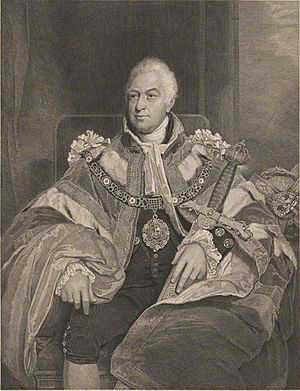Sir William Domville, 1st Baronet facts for kids
Sir William Domville was an important person in London during the early 1800s. He was born on December 26, 1742, and passed away on February 8, 1833. He held the special title of the 1st Baronet in his family. From 1813 to 1814, he served as the Lord Mayor of London, which is a very important leadership role for the city.
Contents
Early Life and Family
William Domville was born in a town called St Albans. His father was Charles Domville, who lived in London. William came from a family with a long history. He later started his own business as a bookseller in London. After some time, he moved back to live in St Albans.
His Important Roles
Sir William Domville held several key positions in London. These roles showed how much he contributed to the city.
Master of Stationers' Company
He became the Master of the Worshipful Company of Stationers and Newspaper Makers. This was a guild, like a professional club, for people involved in printing, publishing, and selling books and newspapers. Being the Master meant he was the leader of this important group.
Sheriff of London
From 1804 to 1805, William Domville served as a Sheriff of London. A Sheriff was a high-ranking officer who helped keep law and order in the city. They also had duties related to the courts and elections.
Alderman and Baronet
In 1805, he was chosen as an Alderman for Queenhithe Ward. An Alderman was a senior member of the city council, helping to make decisions for a specific area of London. In 1814, he was given the title of a Baronet. This is a special honor from the King or Queen, making him "Sir William Domville" and giving his family a hereditary title.
Lord Mayor of London
His most important role was being the Lord Mayor of London from 1813 to 1814. The Lord Mayor is the head of the City of London Corporation, which governs the historic heart of London. It's a very respected position, representing the city at many events and leading its civic life.
Later Life and Legacy
Sir William Domville passed away on February 8, 1833. He was buried in the famous St Albans Abbey. He was married to Sally Finney. Together, they had two sons and five daughters. His life showed how someone could rise to important positions through business and public service in London.


